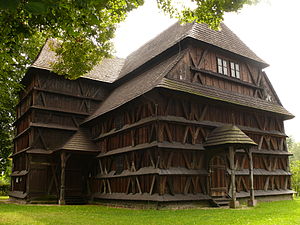Church of the Latter Days Revelation
This article is incomplete because it is pending further input from participants, or it is a work-in-progress by one author. Please comment on this article's talk page to share your input, comments and questions. Note: To contribute to this article, you may need to seek help from the author(s) of this page. |
| Church of the Latter Days Revelation | |
|---|---|
 | |
| Classification | Restorationist |
| Orientation | Protestant |
| Scripture |
|
| Polity | Episcopal polity |
| Governance | Great Ministry |
| Chief Minister | Thomas Andrews-Taylor |
| Region | |
| Language |
|
| Headquarters | Goldeville Church, Goldeville Wallenland |
| Founder | Leviticus Golde |
| Origin | March 18 1899; 125 years ago Allengin, Elbresia |
| Separated from | Elbresian Orthodox Church (1886 AD) |
| Members | 232,457 (2022) |
The Church of the Latter Days Revelation, informally known as the LDR Church or the Revelationist Church, is a restorationist, adventist Christian denomination. The church is headquartered in Goldeville, Wallenland and has 232,457 members since the 2022 Wallene census. The church was the third-largest Christian denomination in Wallenland after the Baptist Church of the Kingdom and the Church of Verdusa.
The church was founded in 1899 by Leviticus Golde in Allengin following his first of many revelations and denouncement of mainstream Christianity. Under Golde's leadership, he preached the New Eden to his growing congregation and held a large following to the dismay of the Elbresian Orthodox clergy. In 1904, Golde had a third revelation and commanded all of his followers to voyage to Wallenland in an arduous nine month journey in three vessels. The 'Goldeites', as they were commonly known, arrived in Valhókoà's Blue Eye Harbour and had already became an annoyance to the local Verdusian Catholic because of Golde's street preaching alongside other preachers such as Elmer Reeter, Benson Bury, and James Barle and alongside rumours of Goldeites committing heinous crimes resulted in the Rainbow Hotel Massacre, killing 9 Goldeites including Golde himself, forcing the Goldeites - now led by Reeter - to move out to countryside. 58 people had been converted to the church priorb to the massacre, one famous example being Running River Andrews. After 2 weeks of moving commanded his followers to settle in a valley in which they named Eden Valley and began construction of Goldeville, naming it in commemoration of Golde. The Goldeites would see conflict between Catholic locals in the Eden Valley Dispute and the Wallene Civil War but they survived, even converting their enemies. Conscription into the colonial army for the World War was vehemently opposed by the church, seeing it as direct opposition to the church'sestablished pacifism though nonetheless, over 130 young men were conscripted.
Church theology includes the Christian doctrine of salvation through Jesus Christ, as well as Golde's Revelations and the Commandment of the Dove. The church has a canon of two texts: the Bible and the Book of Revelations, not to be confused with the Book of Revelation, which contains Golde's Revelations and the Preachers' Revelationsas well as commentary and exegesis of the Bible, modern apocryphal texts considered to be 'lost texts' of minor and major prophets and even angels. Because of these doctrinal differences and Golde's denouncement, many theologists consider to be distinct from mainstream Christianity.
The church's body is the Great Ministry which is led by a Chief Minister, a person which members consider to have a personal relationship with the Trinity; relaying messages between Heaven and Earth and speaking with prophets about advice. The Great Ministry has a panel of 9 ministers, including the Chief Minsiter, many of whom inherited their positions or taken over by their deputy minister. The church's affairs are decided by the panel, working alongside the local council and local organisations and businesses. Both men and women allowed in the clergy, holding the same qualities and religious rights.